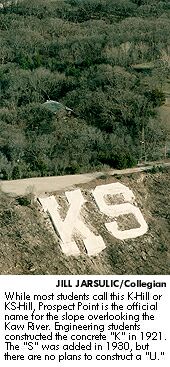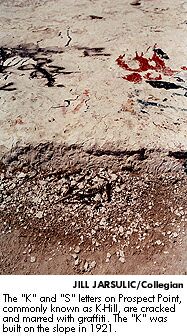|
|
A B C D E F G H I J K L M
N O P Q R S T U V W X Y Z |

|
|
|
|
|
|

|

|
|
KS-WHO? Manhattan's historic Prospect Point stands as symbol for K-State, community; 'U' missing because of high cost, new building codes. Tim Richardson Horse-drawn wagons were used to carry the $350 of supplies up the slope of Prospect Point more than 75 years ago. Today, only one thing stands in the way of its completion - about $100,000.Tau Beta Pi, an honorary engineering organization, does maintenance to the hill each fall. Student president of Tau Beta Pi Troy Brin said it is unlikely that Prospect Point, better known as K-Hill, will ever have a 'U' to match the existing 'KS' in the near future. Brin said he has heard estimates that as much as $200,000 might be needed to add the letter. Higher building code standards are one reason for the price increase. "I think there are a lot better ways to spend money than to put a 'U' on a hill," he said. In 1915, students in the College of Engineering planned to construct a 'K,' so the Civil Engineering Society put a 'K' in loose rock on Bluemont Hill. It soon fell apart. Engineering students at Kansas State Agricultural College later added a concrete 'K' to the current location in 1921, with hopes to construct the three additional letters in the future. Students marched to the hill from Aggieville led by a brass band. About 500 to 1,000 students assisted, using 210 sacks of concrete. The finished letter was 80 feet long, 60 feet wide and one foot deep. Despite student desires to immediately add an 'S,' the letter was not constructed until 1930. According to the Kansas Industrialist, rainy conditions caused a temporary delay around noon that stopped the pouring of concrete, but the workers shortly resumed construction. At a presentation ceremony, the chairman of the 'S' Committee "presented the letter to the college and future students, urging that it be properly cared for and maintained." The total cost for the 'S' was $500. The university later changed its name to Kansas State College, prompting students to want a 'C' added. But that never happened. "By the time they got around to it, the costs were prohibitive," Jeanne Mithen, librarian for the Riley County Historical Society, said. "The '30s were pretty lean with the Depression." When the issue was discussed later in the 1960s, another letter would have cost about $10,000. The university acquired K-Hill in 1980 after the land was deeded to the Kansas Board of Regents because Tau Beta Pi cannot own property. The main priority of Tau Beta Pi concerning the hill is to repair the cracked "S," which is crumbling away. "We've got people looking into it now," Brin said. "It's actually pretty bad." Pledges to the organization must do maintenance work on the hill each fall. About 12 to 14 bags of white Portland cement and additional bags of lime are used to whitewash the letters. The organization also cuts down weeds and picks up trash around K-Hill. "It's a prominent Manhattan landmark," he said. "If we weren't proud of it, we wouldn't continue with its upkeep." Tau Beta Pi typically did its maintenance work following the K-State-KU football game, but strayed from the tradition last year. This gave the organization the opportunity to erase graffiti from the letters, which was sometimes caused by Jayhawk fans. "You get a few people that go up there and put their mark on it," Brin said. "It's nothing we can't handle." Mithen said the letters have brought the community closer together, because the college and the city coexist so closely. She said the hill has been a popular place for students to picnic and relax. "Whether they got on their bikes or rode a wagon, it was always a place to party - 19th-century style," she said. Engineering students who clean the area use ropes tied around their waist to avoid falling down the almost 60- degree hill. In two hours, the group of about 40 can complete the job. Donations and discounts from area businesses also are helpful in the annual event. Brin said many businesses either give to the organization or allow them to purchase material at cost. He said getting contributions from businesses to add an extra letter might be more difficult. "I think the community probably feels that there is some other way to spend the money," Mithen said. With such a hefty price tag to add a letter to the hill, Brin said additional funds would have to come from area businesses and possibly alumni. He said the money should probably go to something more useful. "I think we should maintain what we have up there," he said. "I feel like I have as much school spirit as anyone else, but if anyone was going to donate that much money, I think it would be more important to add a computer lab." This item was published on April 2, 1998 |
F G H I J K
L M N O P
Q R S T U
V W X Y Z